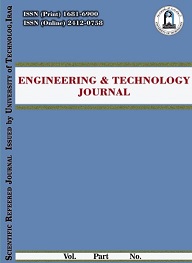Abstract
Al-Najaf is one of the important cities in Iraq due to its high spiritual and religious
reputation that attracts Moslems from different parts of the world to visit the holy
shrine of Al-Imam Ali (peace be upon him). The city of Al-Najaf and particularly Bahr
Al-Najaf area, is expecting a number of large scale construction activities, among these
development activities are the planning of a new tourist city called Sayf Thulfiqar city.
Sayf Thulfiqar city is planned to be the largest tourist city in Iraq. The area of the
proposed tourist city is about 63 hectares, consists of an artificial lake 1000m long
surrounded by twelve towers and a number of small dwellings. This lake is considered
as a big challenge in planning, construction, and sustainability. The challenging points
primarily are the sources of water required to fill the lake, infiltration characteristics of
the soil at site, weather conditions, etc.
The present paper focuses on investigating the rate of water infiltration through the
base and side walls of a pit with dimensions 3m by 3m and 0.5m in depth excavated
and filled with water in the location of artificial lake. The process of filling was
repeated several times with full observation and continuous field measurements. The
results revealed some useful characteristics and correlations regarding the infiltration
of water of artificial lake in Bahr Al-Najaf
reputation that attracts Moslems from different parts of the world to visit the holy
shrine of Al-Imam Ali (peace be upon him). The city of Al-Najaf and particularly Bahr
Al-Najaf area, is expecting a number of large scale construction activities, among these
development activities are the planning of a new tourist city called Sayf Thulfiqar city.
Sayf Thulfiqar city is planned to be the largest tourist city in Iraq. The area of the
proposed tourist city is about 63 hectares, consists of an artificial lake 1000m long
surrounded by twelve towers and a number of small dwellings. This lake is considered
as a big challenge in planning, construction, and sustainability. The challenging points
primarily are the sources of water required to fill the lake, infiltration characteristics of
the soil at site, weather conditions, etc.
The present paper focuses on investigating the rate of water infiltration through the
base and side walls of a pit with dimensions 3m by 3m and 0.5m in depth excavated
and filled with water in the location of artificial lake. The process of filling was
repeated several times with full observation and continuous field measurements. The
results revealed some useful characteristics and correlations regarding the infiltration
of water of artificial lake in Bahr Al-Najaf
